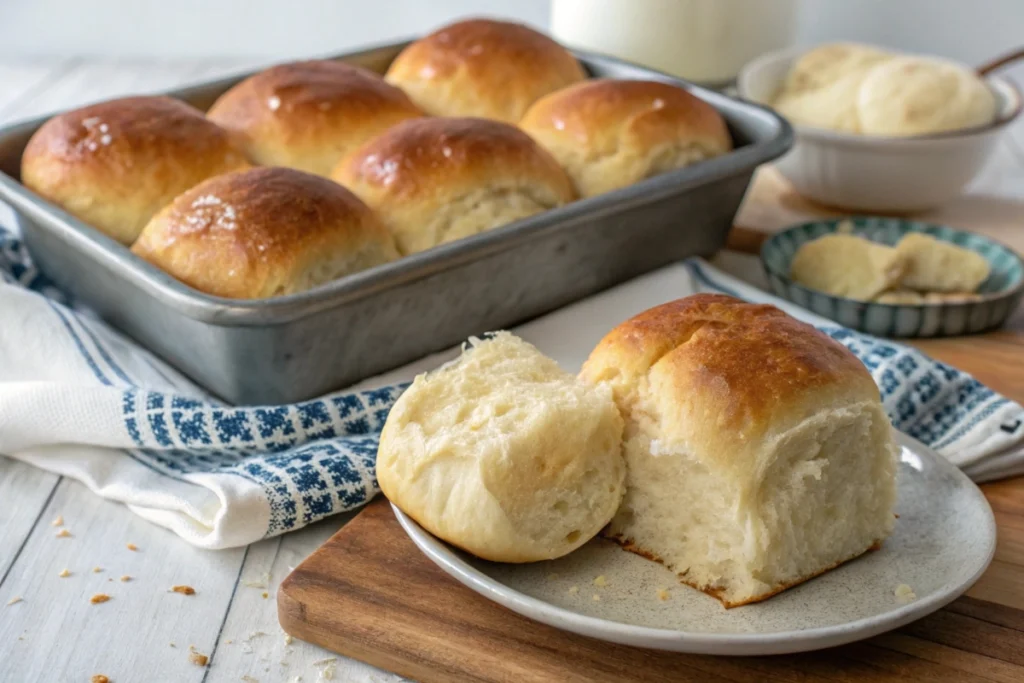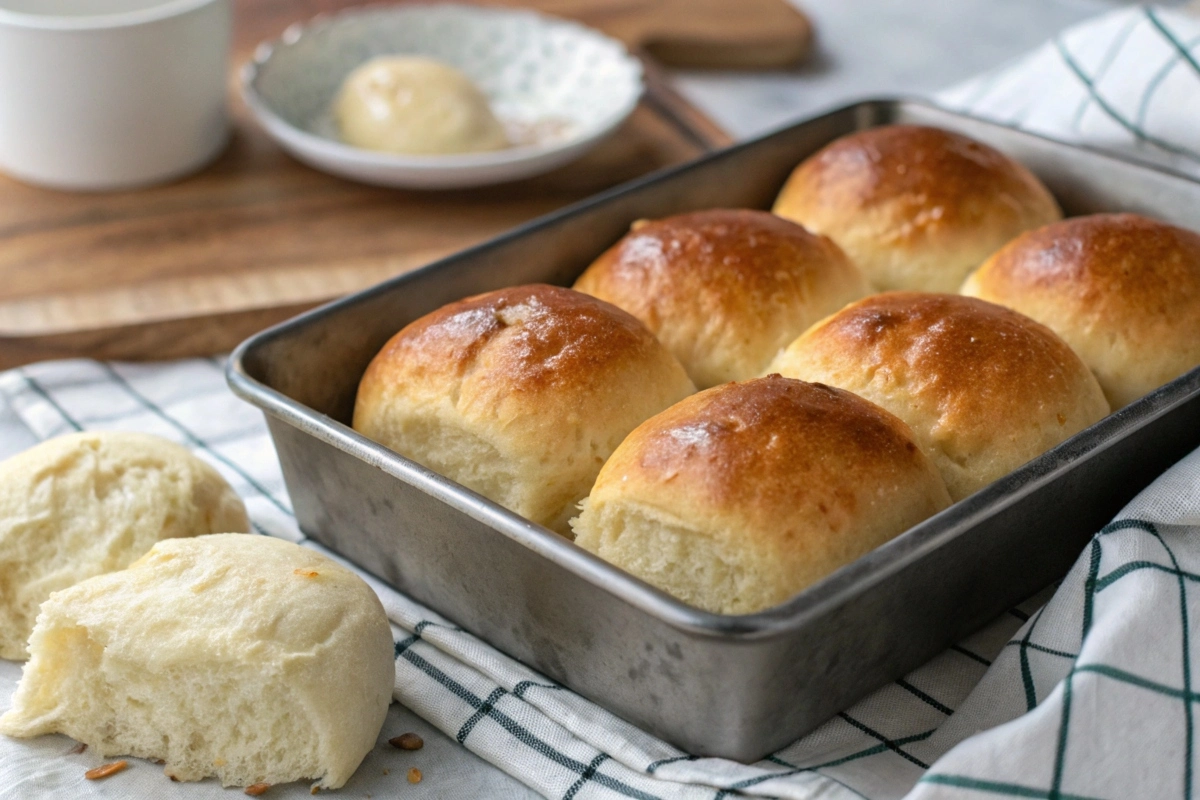Introduction to No-Yeast Dinner Rolls
Why Choose No-Yeast Rolls?
Making Dinner Roll Recipe No Yeast can be a game-changer in your kitchen. This approach is perfect for those moments when you’re short on time but still crave soft and fluffy rolls. Unlike traditional recipes, these rolls skip the yeast, which means there’s no waiting for the dough to rise. With quick preparation, you can enjoy homemade bread without sacrificing flavor or texture. Plus, these rolls are a versatile addition to any meal, whether it’s a casual family dinner or a festive holiday gathering.
Another key advantage is the simplicity. Without the need for yeast, you avoid potential pitfalls like dough that fails to rise. This recipe ensures consistently delightful results, making it a reliable option for bakers of all skill levels. Whether you’re a beginner or an experienced cook, mastering this dinner roll recipe no yeast will undoubtedly enhance your repertoire.
Table of Contents
The Benefits of No-Yeast Baking
Baking without yeast offers several unique advantages. First, it saves time. Traditional bread recipes often require hours of waiting for the dough to rise, but this no-yeast dinner roll recipe eliminates that step entirely. You can have fresh rolls ready in less than an hour, making it ideal for busy weeknights or last-minute gatherings.
Second, these rolls are more approachable for those new to baking. The process is straightforward, with minimal risk of failure. Third, no-yeast baking often uses simple, everyday ingredients that you likely already have in your pantry. Finally, the lack of yeast makes this recipe more accommodating for people with yeast sensitivities. Overall, the dinner roll recipe no yeast approach is a convenient and inclusive way to enjoy fresh-baked bread at home.
Ingredients for No-Yeast Dinner Rolls
Essential Ingredients
To make this dinner roll recipe no yeast, you’ll need just a handful of basic ingredients:
- All-purpose flour: Provides structure to the rolls.
- Baking powder: Acts as the leavening agent, replacing yeast.
- Salt: Enhances the overall flavor.
- Milk: Adds moisture and softness.
- Butter: Ensures a rich, tender crumb.
- Sugar: Offers a touch of sweetness for balanced flavor.
These ingredients come together to create soft, flavorful rolls with a golden-brown crust. The absence of yeast doesn’t compromise the taste or texture, making this a reliable go-to recipe.
Substitutions and Variations
This recipe is highly adaptable. If you’re out of certain ingredients or have dietary preferences, consider these substitutions:
- Use plant-based milk for a dairy-free version.
- Swap butter with coconut oil or margarine for a vegan-friendly option.
- Incorporate whole wheat flour for added nutrition.
- Add herbs, spices, or cheese for unique flavor profiles.
Experimenting with substitutions ensures the dinner roll recipe no yeast meets your specific needs without compromising on taste.
Step-by-Step Guide to Making No-Yeast Dinner Rolls
Preparing the Dough
- Combine dry ingredients: In a large mixing bowl, whisk together flour, baking powder, salt, and sugar. This ensures even distribution of the leavening agents.
- Add wet ingredients: Gradually mix in milk and melted butter. Stir until a cohesive dough forms.
- Knead the dough: Lightly knead the dough on a floured surface for about 2-3 minutes. This step helps achieve a smooth consistency.
Shaping the Rolls
- Divide the dough into equal portions, typically 8-12 pieces depending on your desired roll size.
- Roll each piece into a ball, ensuring smooth edges for even baking.
- Arrange the rolls on a greased or parchment-lined baking tray, leaving space for expansion.
Baking Techniques
- Preheat your oven: Set it to 375°F (190°C) to ensure even baking.
- Brush with butter: Before baking, lightly coat the tops with melted butter for a golden finish.
- Bake: Place the tray in the oven and bake for 15-20 minutes or until the rolls are golden brown.
- Cool: Allow the rolls to cool slightly before serving. This step enhances their flavor and texture.

Tips for Perfect No-Yeast Dinner Rolls
Achieving the Ideal Texture
- Use fresh baking powder for optimal rise.
- Avoid overmixing the dough, as this can result in dense rolls.
- Measure ingredients accurately to maintain the correct balance.
Avoiding Common Mistakes
- Do not overbake; keep an eye on the rolls to prevent dryness.
- Ensure your oven is fully preheated for consistent results.
- Avoid using cold butter or milk, as they can hinder the dough’s texture.
Variations and Flavors for No-Yeast Dinner Rolls
Garlic Butter Rolls
Enhance your dinner roll recipe no yeast with a garlic twist:
- Mix minced garlic and parsley with melted butter.
- Brush the mixture onto the rolls before and after baking for a savory flavor boost.
Herb-Infused Rolls
Add a touch of elegance by incorporating herbs:
- Stir in dried rosemary, thyme, or basil to the dough.
- Sprinkle fresh herbs on top before baking for a fragrant finish.
Sweet Dinner Rolls
For a sweeter option:
- Increase the sugar slightly in the dough.
- Add a glaze made of powdered sugar and milk after baking.
Pairing Ideas for Dinner Rolls
Soups and Stews
These rolls pair wonderfully with hearty soups and stews:
- Creamy tomato soup
- Chicken noodle soup
- Beef stew
Salads and Roasts
For lighter meals or festive dinners:
- Pair with a fresh Caesar salad.
- Serve alongside roasted chicken or turkey for a balanced meal.
Nutritional Information for No-Yeast Dinner Rolls
Caloric Content
On average, one roll contains approximately:
- Calories: 150-180
- Fat: 5-7 grams
- Carbohydrates: 20-25 grams
- Protein: 3-4 grams
Adjusting for Dietary Needs
- Use low-fat milk or a sugar substitute to reduce calories.
- Opt for whole grain flour to increase fiber content.
- Choose unsalted butter for lower sodium levels.
These adjustments allow you to enjoy the dinner roll recipe no yeast while meeting specific dietary preferences.
How No-Yeast Recipes Originated
No-yeast baking has roots that trace back to times when yeast was scarce or unavailable. Historically, bakers relied on natural leaveners, such as baking soda or baking powder, to create fluffy and light bread alternatives. During wars and economic hardships, these no-yeast dinner roll recipes gained popularity as they required fewer ingredients and less preparation time. The convenience of quick-rise dough made these recipes a staple in many households.
Cultures around the world have embraced no-yeast baking in their own ways. For instance, Irish soda bread and Native American fry bread are classic examples. These recipes underscore the ingenuity of cooks who adapted to limited resources while maintaining delicious results. By choosing a dinner roll recipe no yeast, home bakers can connect with this rich culinary history.
Modern Trends in No-Yeast Baking
The rise of no-yeast recipes highlights a demand for faster, simpler bread options. From classics like Irish soda bread to innovative vegan rolls, this baking method offers endless versatility for home cooks.
Additionally, modern adaptations often incorporate unique ingredients, like herbs, spices, or alternative flours, to elevate flavor and texture. As more people explore no-yeast options, these recipes continue to evolve, offering exciting possibilities for creative bakers.
Common Mistakes and How to Avoid Them
Overmixing Dough
One of the most common errors in making a dinner roll recipe no yeast is overmixing the dough. Overworking the dough activates too much gluten, resulting in dense and tough rolls. To avoid this, gently combine the ingredients just until the mixture comes together. Using a spatula or your hands can help maintain a light, airy texture.
- Mix the dough only until combined.
- Use a gentle folding motion.
- Avoid using high-speed mixers.
By following these tips, you’ll achieve soft and tender rolls every time.
Incorrect Baking Temperature
Temperature plays a crucial role in baking no-yeast rolls. Too high, and the rolls may brown too quickly without cooking through. Too low, and they may turn out underbaked or lack a golden crust. Preheating the oven to the recommended temperature ensures even cooking.
- Always preheat the oven fully before baking.
- Use an oven thermometer to check accuracy.
- Place the baking tray in the center for consistent heat distribution.
By mastering temperature control, your no-yeast dinner roll recipe will yield perfect results.

Expert Insights on No-Yeast Dinner Rolls
Advice from Bakers
Professional bakers emphasize the importance of using fresh ingredients in a dinner roll recipe no yeast. Baking powder and baking soda lose potency over time, which can affect the rise and texture of your rolls. Additionally, measuring ingredients accurately ensures consistency in every batch.
“Fresh leaveners are non-negotiable,” says one expert. “They’re the key to achieving that light, fluffy result.”
Insider Tips for Home Cooks
Home cooks can elevate their no-yeast dinner rolls by experimenting with flavors. Adding herbs like rosemary or thyme, or even a touch of garlic powder, can enhance the taste. Another tip is brushing the rolls with melted butter before and after baking to achieve a rich, golden crust.
Advanced Techniques for Experienced Bakers
Using Buttermilk for Better Flavor
Incorporating buttermilk into your dinner roll recipe no yeast can add a tangy depth of flavor while also tenderizing the dough. The acidity in buttermilk reacts with baking soda, helping the rolls rise beautifully.
- Substitute regular milk with buttermilk.
- Adjust the baking soda amount to balance acidity.
This simple swap can transform ordinary rolls into a gourmet delight.
Incorporating Cheese or Seeds
For bakers looking to add complexity to their rolls, mixing in shredded cheese or sprinkling seeds like sesame or poppy on top can provide unique textures and flavors.
- Fold cheese into the dough before shaping.
- Brush the tops with egg wash and sprinkle seeds.
These additions make your no-yeast dinner roll recipe stand out at any meal.
Storage and Reheating Tips
Best Practices for Storing Rolls
To maintain freshness, store your rolls in an airtight container at room temperature for up to two days. For longer storage, freeze them in a sealed bag.
- Wrap individual rolls in plastic wrap.
- Use a freezer-safe bag to prevent freezer burn.
Reheating Without Losing Texture
When reheating, avoid using a microwave as it can make rolls rubbery. Instead, warm them in the oven at 300°F for 5-10 minutes. For frozen rolls, thaw at room temperature before reheating.
- Place rolls on a baking tray covered with foil.
- Add a small dish of water to the oven to maintain moisture.
These methods ensure your no-yeast dinner rolls taste freshly baked.
Frequently Asked Questions About No-Yeast Dinner Rolls
What Makes These Rolls Rise Without Yeast?
The leavening agents, typically baking powder or baking soda, create carbon dioxide bubbles that cause the dough to rise. This chemical reaction eliminates the need for yeast.
Can I Use Gluten-Free Flour?
Yes, gluten-free flour can be used, but the texture may differ slightly. To improve the structure, consider adding a binding agent like xanthan gum.
How Long Do These Rolls Stay Fresh?
Stored properly, no-yeast dinner rolls stay fresh for two days at room temperature or up to three months in the freezer.
For more about bread and related baking techniques, you can visit the Bread Wikipedia page.
Conclusion
Why No-Yeast Rolls are a Must-Try
Skipping yeast in bread-making has its perks:
Adaptability: They complement everything from easy weeknight dinner recipes to festive holiday meals.
Quick Preparation: Unlike traditional rolls, no-yeast recipes take under an hour.
Simplicity: These rolls are foolproof, making them ideal for novice bakers.
Final Encouragement for Bakers
Don’t hesitate to experiment with this accessible recipe. Whether you’re a novice or an experienced baker, no-yeast dinner rolls are a delightful addition to any meal. Enjoy the satisfaction of creating homemade bread without the need for yeast.

